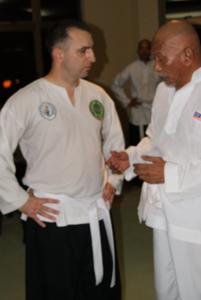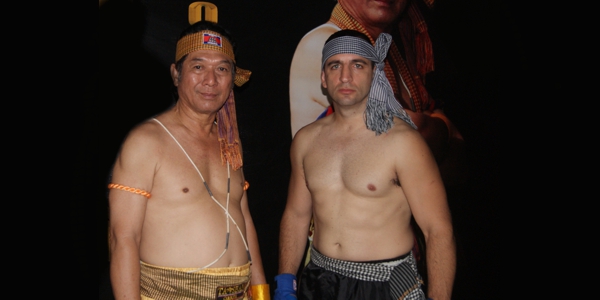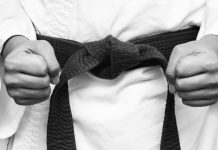
Learning Khmer Kick Boxing with Paddy Carson
“We have to remember why we are in that ring we are there to hurt the other guy we aren’t in there to make love to him. So, the quicker we can hurt him, the better. You want him to think I don’t want to get hit like that again.” Paddy Carson.
The pads POP! As a Khmer fighter nails them with a series of perfect round house kicks. When the Khmers kick, the leg comes around like a baseball bat, and the shin smashes into the target, decimating it. This is not Tae kwan Do or Karate, this is Bradal Serey, Khmer kickboxing.
“It’s all technique. You have to get the technique right first, then you will get the explosion on your punches and kicks in the fight.” Says Paddy Carson, the owner and principal trainer of Paddy’s Gym, in Phnom Penh.
Khmer pop music blares as Paddy’s stable of about twenty Khmer boxers go through their paces. The assistant coach Socheat blows the whistle signaling the beginning of the round. The fighters always train three minutes on, one minute off, just as in a real boxing fight (in western boxing). Many trainers live by the adage “you will fight the way you practice.” Timing your workouts will prepare your body a professional fight.
Sports research has proved that western boxers have the most powerful punches of any combat sport athletes. Paddy’s fighters use western boxing as a base for their Khmer boxing.
“You should learn to punch like a boxier but kick and elbow like a Khmer boxer. Then you will have the whole package.” Says Paddy, who has trained over 14 world title holders.
Before coming to Cambodia, Paddy worked as a trainer in Thailand for 13 years. The first foreigner who was ever granted a professional boxing license, he came to Cambodia to help support Khmer boxing and has a dream of building a Khmer fighter into a world title holder.
“I think elbows are better in Khmer boxing than in Muay Thai. Unfortunately, Cambodia has had all civil wars, and the Bradal Serey instructors were killed by Pol Pot. So, throughout the Twentieth Century, Cambodian boxing went up, and then down, and then up and down. Thailand has gone continually up and up. Thailand have marketed the sport all over the world. Thailand has joined the international bodies and have produced world title holders. If Thailand and the Philippines can produce world title holders, I believe that Cambodia can too. The Khmers are tough boys. They come from the provinces with nothing. Some of them don’t even have money for food, but they train hard. They are respectful to me and the assistant coach. They always bow when they see us. And now they know that if they listen to what I teach them, they can win.”
In addition to his professional Khmer boxers, Paddy has a number of westerners training with him. It has almost become a clich¨¦ for westerners to go live in a camp in Thailand and study Muay Thai. But in Cambodia, there aren’t a lot of gyms which are really equipped for westerners. The average westerner who is starting to learn Khmer boxing is already past the age that Khmers will retire from the ring. Plus, the training and fighting style need to be modified to match our larger bodies and lesser flexibility.
Some coaches stress high kicks and head kicks. They make you stand at a bang and smash it as high as you can with your shins. Paddy disagrees with this type of training.
“We are all built differently in this world. Some people can do double flying spin kicks or whatever, but some people can’t. If you aren’t a high kicker then what do you want to do high kicks for? You do what you were built to do. If you can’t do high kicks, then do low kicks. In Thailand, I told my foreign fighters, don’t train and fight like the Thais.”
“It is stupid to try and kick your opponent in the head in the early rounds when you are fresh and he is fresh. You are never going to get it. How often in fights do you see the guy get knocked out with a high kick? Almost never. Wait till he is tired. Wear him down. Work the body. Work the legs. In the later rounds, when he gets tired, and you are still fresh, then you go for the head kick.”
Working the legs means repeatedly kicking your opponent’s thigh with your shin. A normal man can only withstand two or three kicks to the thighs, before his leg will buckle and he will go down, involuntarily. Even a seasoned fighter can be chopped down, like a tree, if you repeatedly land the same kick on the same portion of his leg, again and again.
“My fighter, my world champion, was very short and he used to fight people who were a foot taller than him. He wasn’t a high kicker, so I told him go in there, work the legs, work the legs, and throw combinations. He knocked his opponent out.”
Paddy wasn’t suggesting that high kicking is a bad thing, only that it must be appropriate for your ability.
“If you were a high kicker then I would train you that way. Not that I couldn’t teach you that, but why do that all the time. Go for the body, go fro the arms.”
Very few fighters go for the arms. This means kicking your opponent in the biceps with your shins. Very few people can stand up this type of punishment. The arms will quickly become useless. Eh Phou Thoung, Cambodia’s greatest kick boxing champion, is known for kicking his opponent’s in the biceps. In his career, he has broken the arms of several of them.
“Ninety percent of head kicks don’t reach their target. The opponent sees it coming and he blocks with his leg or his shin, and possibly, you hurt your leg. Don’t do that! Wait till he throws a high kick, then attack.”
“I like a high kicker, the higher the better. During a high kick, he is wide open and it takes longer for the leg to come down. He is defenseless and off balance the whole time. When the opponent does the high kick, kick his base leg.”
Another opportunity that many fighters miss is kicking the inside of the leg or kicking the base leg. When an opponent throws the high right kick, his left leg, the base leg is a wide open, inviting target. You can lea your head or duck your head slightly, to avoid the high kick. At the same time, shoot a kick in and hit the inside of his left thigh or calf muscle. With all the weight on that one leg, there is a good chance the man will go down. At the very least, he will be in a lot of pain.
“When I was fighting I was a take down artist. I would catch the kick, trap the leg, and kick the base leg out from under him. This is something we don’t see enough of here. You also don’t see a lot of inside low kicks. I tell my guys smash the inside kick just above the inside of the knee.”
Brining modern innovations to a centuries old sport, which is so steeped in tradition and national pride can be difficult. Reasonably, the Khmer fighters are resistant to adopt new techniques, brought to them by a westerner.
“I teach Richard, my foreign fighter, all the new techniques first. Then, the Khmers see him improve, and they pick it up and improve too.”
Having an extensive background in both western boxing and professional kick boxing in the west, Paddy stresses movement and position.
“When you kick, the foot has to come back to perfect position again so you can throw another technique. Some of the Thais and Khmers throw a kick and it is thirty seconds till they do something else. You need to be moving and doing something all the time. If you watch the big kick boxing matches on cable, and listen to the foreign commentators from Australia they are saying if the Thais don’t start doing combinations they will not be able to keep up with the western fighters. I have been doing that for twenty years, teaching my guys combinations.”
Kicking is almost the only thing that many coaches teach. Once a guy has a decent kick, they put him in the ring and expect him to win.
“Richard is still a novice, but he is kicking like a guy who has had thirty fights. But now he needs to get the ring craft. When you get in the ring on fight night, with all the lights and TV cameras, you get nervous and lose thirty percent of your energy from nervousness. It is only when you have been in the ring a lot getting in the ring again and again that you will calm down. And you will fight in the ring the same way you practice.”
“This is an advantage of Khmers and Thais. Many of them have had seventy five fights, and they don’t get nervous at all. But they have other problems. Now, we have Thais going to England with 70 fights and losing to a guy with thirty fights.”
“The Thais and Khmers are quite static when they fight. They get knocked out sometimes by punches that wouldn’t knock out another fighter. In the west, the sport is being dominated by people with boxing and kicking background. But here, they aren’t learning the boxing. I have seen fighters here knocked out with a jab.”
Having trained and fought on both sides of the border and both sides of the globe, Paddy sees the strengths and weaknesses of the Thai fighters and believes that with his help, the Khmers can exploit those weaknesses and become world champions.
“If a western boxer can learn Muay Thai and go to Thailand and win a title, then I believe that Khmer boxers could do it.”
Once the Khmers start winning international competitions, then they will be able to reclaim the name, Bradal Serey, and tell the world the true origin of kick boxing.







